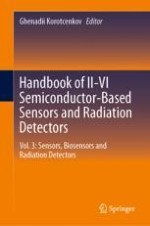Abstract
This chapter presents the fluorescent biosensors (FBSs) using II–VI compound quantum dots (QDs). To make it easier for the readers to follow, we organise the chapter as follows. First, we briefly describe what biosensors are, paying more attention to the FBSs. Particularly, the unique advantages of fluorescent II–VI QDs in FBSs, despite certain limitations relating to the Cd-containing toxicity to the human body, are made clear. Then, aiming to possible applications, FBSs can be reasonably classified into five kinds for detecting: (i) viruses, mycotoxins, pathogens, specific proteins, enzymes, nucleic acids, cellular, in vivo targeting imaging for diagnostics, disease treatments and health care; (ii) residues of pesticides, herbicides, growth-promoting hormone in agricultural productions; (iii) banned/toxic residuals, bacteria-contaminated in foods, drinking water, agricultural products for food safety; (iv) heavy metals in environmental samples and (v) latent fingerprints, security markers and TNT explosive for criminal, forensic and security investigations. In each kind of FBS, we illustrate the structure/design, operating principle, signal detection, sensitivity/limit of detection, linearity, precision/repeatability and reproducibility, as well as its advantages/disadvantages. Finally, in the conclusion, we remark the FBSs based on II–VI QDs possess unique advantages such as easy fabrication, high fluorescence efficiency in the whole UV-to-IR spectral region, large Stokes shift with the emission dependent on their size or composition, particularly when they are in the type-II quantum structure that has long fluorescence decay time for fluorescence imaging out from the natural/self-fluorescence noise.
